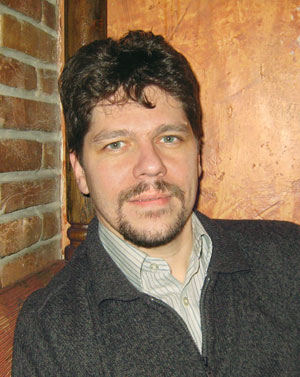
I met Hungarian flutist and composer Gergely Ittzés at the 25th International Music Festival in Brasília, Brazil in January 2003. Along with Brazilian flutist, Sergio Barrenechea, we team-taught and played various concerts during the three-week festival. What impressed me most about Ittzés, besides his amazing dexterity with extended techniques, was his creativity as a composer. In one class he played his flute solo piece, Mr. Dick is Thinking in Terms of a Blues Pattern, and our jaws dropped. He has written about 20 pieces, all for flute with various instrumental combinations.
During the festival we spoke about his system for playing double stops, composition, performance, and teaching. He has an endless curiosity about sound, rhythms, and styles; the flute just happens to be his instrument. He goes beyond its confines and eagerly explores all corners of the instrument’s capabilities. Six years, almost to the day, had passed when we met again for this interview in January 2009. We sat down for a long lunch – this time in Budapest.
Gergely Ittzés was born in Győr, a Hungarian city approximately 120 km from Budapest. The family moved to Kecskemét, the birthplace of Zoltán Kodály, so his father could work at the then newly-established Zoltán Kodály Pedagogical Institute of Music. Ittzés’ father still teaches music theory there and is also a musicologist. His mother has the same music education background as his father and holds an additional degree in English. She has taught music courses in English at a music high school for 15 years.
Childhood.jpg)
Coming from a musical family and a culture that encourages music education, it was natural for Ittzés and his brothers to be interested in music:
“As small children we were surrounded by music, so it was obvious that we would start an instrument. My parents wanted us each to start playing when we were six. My older brother, Tamás, is a violinist who just finished his doctorate in violin and started teaching at a university in Debrecen. My other brother, Ádám, is confined to a wheelchair and can’t play music, but he probably listens to it more than I do. He’s married, has two daughters and three diplomas, one each in history, theology, and library sciences.
“Because Tamás played violin my parents thought I should play a wind instrument. Children usually start on recorder in Hungary and switch to a bigger instrument later, so that is what I did. I was quite upset, however, because I didn’t think the recorder was as serious as the violin. This might be one of the reasons that I’m still very influenced by string playing. I have a CD called Violin Works on Flute in which I demonstrate how flutists can reach the level and expressive skills of string players. Accompanying the CD is an article I wrote titled, ‘Envious Flutists.’
“My recorder teacher was an oboist and wanted me to switch to oboe after four years. We soon figured out that the oboe was not for me. I broke the first reed immediately, and my lips weren’t right for it either. My teacher thought flute would be better, but I got frustrated with it because it was so much harder than recorder. I ended up stopping after six months but then found that I missed it. I went back to my teacher – an extremely nice man – but because he was an oboist, he taught me to play the flute improperly. It is quite common for wind players to teach more than one instrument in Hungary.
“I was 12 when I realized I would be a flutist. I had different plans before, but I had this sudden revelation like a thunderbolt. The idea to be a musician became a conviction, a devotion. Along with flute lessons I had been taking percussion lessons for three years by this time, and while I’m not a very talented percussionist, the percussion work improved my sense of rhythm and gave me the feeling of creating a musical sound in another way. Later I studied piano and use it now for its harmonic capabilities to improvise and to get an overview of a piece.
“I started to listen to the radio all the time. Our classical music station posted a detailed program; I always noted when to listen, so that during the afternoon when I was practicing, I could know that there would be a flutist playing in five minutes. I started collecting information that way for many years, but I must say that I was not very impressed by the flute sounds I heard. Most were either too fuzzy and wooden or too thin.”
 Important Teachers
Important Teachers
When he attended a summer music camp and heard Hungarian flutist István Matuz perform, he found the answer. “I loved his sound and his approach to old music. I later discovered that my parents had one of his records, which I listened to daily. It included the Prokofiev Sonata, the Martin Ballade, and the Boulez Sonatina. Matuz fostered my imagination for a very long time. Later I met many other interesting musicians, and our paths diverged, but Matuz was the first strong influence on my flute playing. He is a soloist and does a lot of work in multiphonics and extended techniques. When I met him, our relationship became quite close. Although he was never my official teacher, I took courses with him, and we met often. Since that time we have played and done many summer classes together.”
Besides Matuz, Ittzés also traces his interest in extended techniques to Robert Dick: “I heard a concert that he recorded about 20 years ago that influenced me a lot. His approach is very different from that of Matuz, whose focus is to get as many sounds out of the flute as possible. Matuz’s sound is very rich when he plays multiphonics but not as classical as Robert’s double-stop playing, in which he plays so clearly that you can hear both pitches. This clarity influenced my approach, and I was inspired to make my double-stop chart. I learned the theory from Matuz, however, as he also knows a lot about flute acoustics and how to do the fingerings based on acoustic principles.” During high school Ittzés studied with Ákos Dratsay, a newly-graduated flutist from the Liszt Music Academy in Budapest. “He was also influenced by Matuz, and he established my technique and approach.”
At 18 Ittzés moved to Budapest, where he attended the Budapest Liszt Academy of Music for the required five years. He studied with Henrik Pröhle, who was less of an influence on his playing than Matuz, and later, Auréle Nicolet, who Ittzés met in a course when he was 19. “Auréle Nicolet was the other flutist who had a huge effect on my flute playing. He was very musically intelligent. I also had wonderful chamber music teachers in Budapest who weren’t flutists, such as composer György Kurtág and the legendary pianist Ferenc Rados, teacher of András Schiff, among others.”
Competitions
In 1987, shortly after his entrance into the Budapest Liszt Academy, Ittzés won third prize in the Valentino Bucchi International Flute Competition in Rome. The following year he was in the finals of a competition in Duino, Italy, which is how he initially met Nicolet, a member of the judging panel. “I was third, but they didn’t award a third prize. Emmanuel Pahud won the first prize that year. Later I tried some other competitions, and felt that the better I played, the less successful I was, so I stopped going to competitions.
“There was always a conflict between whether to adjust to a competition’s requirements or whether to go my own way. I was influenced from outside the mainstream and lost perspective on what I was doing – whether I was playing honestly or reacting to something I was told to do. Competitions don’t really accept people who do not conform. It is much easier to compare players when their styles and qualities are similar. Those who play in an obviously different manner are usually eliminated. I had this revolutionary approach that was not attractive to judges. Now mainstream flutists appreciate me more when they hear me play. They don’t find my playing strange.
“Another problem I had during competitions was my technique. I realized that there was a certain dichotomy between my musical imagination and my technical skills that I only resolved after my official studies terminated. When I was 25, I discovered a way to be flexible enough to produce the sound I wanted to hear.
“The idea of conforming to one ideal sound is a bit too stiff for me. Even worse is playing standard repertoire such as a Bach sonata, or the Mozart or Reinecke Concerto, with the same approach that you would play an orchestral part. An orchestral approach is limited to playing with a nice sound, vibrato, and intonation, but with little attention to personality, communication, and musical structure. I find this a very narrow path. When you play a whole sonata you are responsible for the form and, in a way, for the instrumentation of the piece. You have to use more extreme colors, timing, and vibrato. Most often competition winners play solo repertoire as if they were playing in an orchestra, not allowing themselves much individuality.
“In 1998 I went to a special competition – the Aleksander Tansman Second International Competition for Music Personalities in Poland, and I won the Grand Prix. Patrick Gallois, who is a great musician, was on the jury. I had heard his recordings and watched him teach once and thought his approach was similar to mine. He also felt the similarity.”
Finding His Own Style
After graduating from the Liszt Academy, Ittzés went to the Prague Mozart Academy for a year, where he studied with a variety of instrumentalists, not just flutists, and developed friendships, including the one he has with keyboardist and composer Anthony Newman. Later he received a scholarship to Banff Center where he participated in the Fall program and created a piece based on a Sioux Indian tradition for four flutes called Vision Pit. Ittzés structured the piece but didn’t dictate exact notes and describes the work as “organized improvisation.”
While at Banff, he also collaborated with jazz musicians, which is something he had done before. “I never studied jazz formally but had worked on it on my own. Jazz is more about opening your ears. I didn’t get very far in it and realized that I have to limit the number styles that I play. I just didn’t have the time to spend with jazz, but I may come back to it in the future. I still learned a lot, and it has changed my approach to playing composed music.”
Recently, Ittzés returned to the Liszt Academy to get his doctorate in music. In the past few years Hungary has changed its higher education system and now requires teachers to have a doctorate in order to teach arts at the college level. “Music education is very well-organized in Hungary. Unfortunately, new politics and financial considerations are affecting the music education system. Hungary has had a strong system of music schools, such as State music schools for children. To become a musician, students decide at the age of 14 to go to the conservatory, which is at the high school level. Many Eastern European countries also have this system. After the conservatory you can go to a college or university.”
“Now Hungary is using the Bologna System, which copies the American system with bachelor’s and master’s degrees. Musicians with only a bachelor’s degree can’t teach in a music school because of the new rules. Even performing artists with master’s degrees are not allowed to teach because they have not taken pedagogical classes. A performance degree has to be combined with an extra year of pedagogy study in order to teach. So far Hungary has just the bachelor’s degree. In 2010, the first bachelors’ degree students will graduate, and schools will add the master’s level.
“In 2001 I received the Liszt Prize, one of the important prizes of Hungary’s Ministry of Culture; it is the equivalent of a doctorate, although you don’t have to do the coursework. I did the habilitation, a required exam to become a professor that includes playing a public concert and teaching in your mother tongue and in a foreign language. Because of the Liszt Prize I didn’t have to take the doctoral courses, but I decided to do them anyway. Writing my thesis is all that remains to be done. It will be about thinking in an harmonic way when we play, especially solo flute works. It’s more about implied or hidden polyphony, as in the Bach Partita. Even an Anderson etude is based on very fine harmonic knowledge. As part of my thesis, I transcribed some flute etudes and composed little piano pieces to demonstrate the harmonic background. The thesis includes a lot of theoretical information with some rather radical ideas.”
On Sound
“Some people think my sound is strange because it is so open and full, and others love it. The first item of importance in tone development is to consciously use the resonant space within the mouth and between the teeth and upper lip as much as possible. The other important factor is that most flutists play with air that is too fast. After a certain point, the faster you blow, the less sound you produce. It feels powerful because you are working for it, but acoustically, instead of sounding louder, it sounds softer. The acoustic reason can be explained this way. When playing in the middle register, you hear the fundamental in the low register as a very soft whispering sound. Depending on the airspeed, the pitch of the fundamental remains pretty constant, but the overtone – the note you are playing – is obviously affected by the airspeed. When the interval (octave) between the barely-audible fundamental and the fingered sound is perfect, the sound is strengthened. When the octave is too wide (the fingered note is sharp), the vibrating air is not correct enough to strengthen the sound. The tone’s timbre will sound overblown. Therefore, it is essential to find the ideal air speed and resonance space in the oral cavity.
“It’s important to combine the face and the mouth. The lips should not resist the air too much, but rather direct the air and create the ideal shape for the resonance. Sound waves return into the mouth as well. It’s like making a church within your mouth. I used to call it the ‘technique of slow air.’ Very often I say that you should think of blowing with warm air, not cold air. It’s also what you do with your tongue in the mouth, and so forth.
“Most flutists think that they should focus the air column to produce a focused sound, but I think about this differently. With the proper open, round shape, the correct angle, air speed, and resonating space in your mouth, the sound is strong without trying to focus it. There are five aspects of a good sound:
1. The vertical placement of the flute on the lower lip – not too low, not too high.
2. The horizontal placement of the flute on the lower lip exactly below the aperture.
3. The flute must be parallel with the lip line.
4. An exact 90-degree angle between the embouchure plate and the air as it exits the mouth.
5. How much to roll the flute in or out.
The edge of the embouchure hole should be opposite the air column and divide the air stream in half. The surface of the embouchure hole should be 90 degrees to the player’s face (at a right angle) because the embouchure plate is usually shaped to accommodate this position. This is a separate issue from the jaw’s role and the subtle way the lip muscles move.
“There are three different aspects of the sound production that are useful to be aware of and use consciously: first, the sound you imagine; second, the sound you feel; and third, what really happens. These three don’t always match each other however. For example, it is good to realize that even though it feels as if we blow the air through the tube, that’s not what really happens. The air is generating the resonance like electricity generates light, but the air molecules move back and forth and not away from the player. If players understand this, they might not continue blowing with the same force.”
The Performer
Currently Ittzés plays a silver flute with a lip plate that is turned approximately 10 degrees to the right to follow his asymmetrical embouchure and to help him hold the flute more comfortably.
As an active performer and recording artist, he plays in groups that range from the TeTraVERSI flute quartet, comprised of Ittzés and three of his former students, to the UMZE ensemble. (“UMZE” stands for the New Hungarian Music Society, which was started by Bartók and Kodály in 1911 to perform their music and that of their contemporaries).
His 14 recordings range from chamber and traditional music to new works, violin transcriptions and works of Karg-Elert, Doppler, and his long-time collaborator, Anthony Newman. Presently, he is working on a series of recordings for a Chinese label with Newman and some other well-known Hungarian pianists. The CD collection will be called The Great Book of Flute Sonatas.
According to Ittzés, “The project will include all the major flute sonatas composed in the last 300 years. It will be a subjective selection, but I will play all those that are great, famous, or both. There are some sonatas that I don’t find great but are often played, and others that are great but little known, like those of Dubois, Jongen, and my Hungarian favorite, Lajtha.”
Teaching
Ittzés has been teaching flute at the Széchenyi University in Győr since 1997, when he was 27 years old. “In my teaching, I try to make a very direct connection between technique and musicality. I believe that there are objective points that can be relied upon and stated exactly. I would like to create a certain complexity in my method, and maybe this is what students like when they choose to study with me. I never put extra emphasis on performing art, sound, or technique but try to focus on all of them at the same time.
“Contemporary techniques are also organic parts of my teaching method and not just specialties. Multiphonics, for example, can be very helpful in teaching classical or conventional repertoire. I don’t push students to do experimental pieces, but if they want me to help, I will. I usually use these techniques as exercises for tone development. For example, if slurring between two notes is problematic, I show them a fingering where it is possible to play the two notes together. After practicing the double stop for a minute, it is easier to play with the normal sound. Double stop exercises also help students learn to support the sound and control the lip muscles. When playing double stops, it is easy to know when you make a mistake because you lose one of the notes. It is not just a little waver in the sound. Practicing double-stops also improves your ear, which takes us back to violin playing. One advantage about violin is that you can have several sounds at the same time. On the flute it is a great feeling, too, as it adds another dimension.
“I have a chart of about 400 double-stop fingerings that can be downloaded from my website. (http://www.ittzesgergely.hu/index_en.asp) I am in the process of creating a software form of this chart. The chart not only has the fingerings but other information including dynamic limitations. I used a special clever and short fingering notation that comes from István Matuz. The principal is easy and logical to understand, but it takes a few days or weeks to put it into practice. Writing the double stop fingerings is faster because you don’t have to make a symbol for every hole, only for those that are open.
“Another important part of my approach to music is the way I think about performance. The inspiration comes from a book, by the famous Russian actor and director Konstantin Stanislavski (1863-1938). I draw parallels between what he says about theater performance and what I think about music performance, trying to experience the music deeply and become one with the role that I am playing.”






